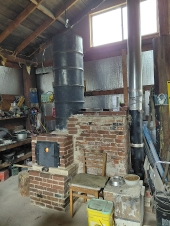


Cristobal Cristo wrote:Good heater should be efficient and it's efficient when it has mass to store exhaust heat. Without that it' just a less or more complicated bonfire. There are various methods of efficient combustion - a long fi 300 pipe lined with clay will be an excellent firebox. I would suggest to focus the design on the exhaust energy storage that can be quickly built with what is available. Usually the most ubiquitous material is dirt and some plant fiber.
You could just prefabricate the L-shaped core. It would not be too heavy, so it could be shipped together with a top plate.
Then the client would need to line it (or not - for ultimate simplicity at the price of shorter lifespan) with clay and build a dirt bell around it with top plate on top that would:
-make a ceiling - the most complicated part in any masonry structure
-quickly radiate heat at the beginning of combustion
-could be used for cooking
I can not imagine anything simpler having thermal mass and built with limited material availibility.
If the client has an access to some tank/barrel then it could be also used as a substrate for clay but would require metal cutting.

Fox James wrote:The wooden box full of stones will not be a very effective method at all, certainly not compared to solid mass but I guess it might work for you as a compromise.
A far more up to date and effective method is a bell or enclosure built around the stove, in theory this might be an option for you.
So a basic description would be replacing the more traditional barrel with a solid mass around the stove.
An even simpler method might be a steel box ( barrel alternative) with stacked bricks around three sides.
Basically a piped mass system ( where a pipe is covered in clay) is well out of date as bell systems have proven to be more effective and easier to operate..

Roelof Groenenboom wrote:Hi Leslie,
Maybe this will help? https://roquetinho.eu
It's a detailed industrial design, intended for both DIY and factory production.

thomas rubino wrote:Yes, Paul's pebble heater has a wooden box that contains the barrel edges.
However, this is a semi-permanent build in his home; here we are discussing a bomb shelter.
Unfortunately, the Ukrainian people are forced to spend more time in them than they want to.
You can use anything available to hold and seal those long edges. All you need is to keep them in place. Mud, bricks, and rocks come to mind.
Fox brings up a valid point: the risers need (should) to be insulated; it's very accurate, and without it, performance will suffer.
But does this really matter?
I come back to this.
It is for a temporary Bomb Shelter.
The whole idea is to remain as warm as possible with as little wood as possible.
You don't want or need longevity, efficiency, or looks; you just want people to stay alive until they can stop huddling in bomb shelters and return to their homes if they are still standing.
Edit)
I just read your latest post.
I did not understand your needs, especially regarding the need for an engineer to sign off on the project.

Fox James wrote:
The basic priceable of how a rocket stove works is based on a very high heat situation inside the stove and that needs to be insulated. Perlite, Vermiculite, rock wool or ceramic fibre?

Fox James wrote:The J tube is the only, easy to build, reliable rocket stove, but you still need to address some facts like the internal riser really needs to be insulated with some form of high temperature insulation.
The whole J tube can be made from fire bricks or even clay bricks, in an ideal world lightweight insulating bricks would be perfect as the stove could just be built and taken apart very easily.
I doubt in anybody outside of the environment can really understand the situation or imagine exactly what is available?
The basic priceable of how a rocket stove works is based on a very high heat situation inside the stove and that needs to be insulated. Perlite, Vermiculite, rock wool or ceramic fibre?

thomas rubino wrote:Yes, you can use sheet metal.
When using barrels, they are split lengthwise and the end caps are cut off except for 2" or so at the arch to retain a half-barrel shape.
When using sheet metal without support, I would hesitate to use it as a bench or a bed.
It might support the weight, and it might not.
You could weld tabs on the inside and use nuts and bolts to place a "stiffener" across the arch when setting it up, and unbolt one side to lay it flat for transport.

Leslie L Wilson wrote:
thomas rubino wrote:Hi
The half-barrel stratification chamber is extremely easy to throw together and quickly packed up if you need to vacate.
Incredibly difficult to lay hands on used barrels. All kinds of Metal Ukrainians fiercely hold on to and recycle.
Can our welder fashion stratification chamber from sheet metal? It looks like flat side goes down, curved part up top, correct?
More questions than answers when I watch And rematch Paul's video. Has there been any tested followup to the Qs posed by the video?

thomas rubino wrote:Hi Leslie
I am assuming that you know the different size J-Tube dimensions.
If not, we can easily give them to you.
You may find that a K-Tube design works better for you.
As these are temporary stoves to save lives, there is no reason not to quickly weld them up from metal.
The half-barrel stratification chamber is extremely easy to throw together and quickly packed up if you need to vacate.
Mud of any type can be used as well as any large stones, metal items, bricks, or anything else that remains in the area.
